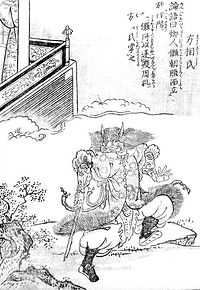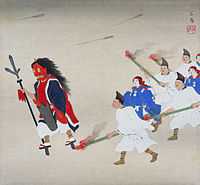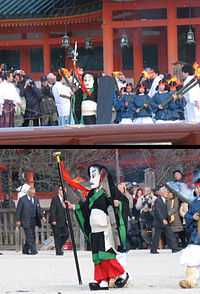Fangxiangshi
| Fangxiangshi | |||||||||||||||||
| Chinese name | |||||||||||||||||
|---|---|---|---|---|---|---|---|---|---|---|---|---|---|---|---|---|---|
| Chinese | 方相氏 | ||||||||||||||||
| Literal meaning | directions scrutinizing master | ||||||||||||||||
| |||||||||||||||||
| Korean name | |||||||||||||||||
| Hangul | 방상씨 | ||||||||||||||||
| |||||||||||||||||
| Japanese name | |||||||||||||||||
| Kanji | 方相氏 | ||||||||||||||||
| Hiragana | ほうそうし | ||||||||||||||||
| |||||||||||||||||
The fangxiangshi was a Chinese wu-shaman specialist in ritual exorcism who wore a bearskin with four golden eyes, and carried a lance and shield. His two primary duties were orchestrating the seasonal Great nuo ritual to exorcise disease-causing demons, and leading a funeral procession to the tomb and entering the burial chamber to drive out malevolent earth spirits such as the wangliang.
Etymology
The obscure etymology of fāngxiàngshì is a subject of disagreement among specialists. The name combines three words, with the following Old Chinese pronunciations and meanings (Schuessler 2007: 231, 531, 466):
- paŋ 方 "square, a regular thing, side, region, country; two boats lashed side by side, raft; just now, to begin; method, law, norm, standard"
- *saŋh 相 "look at, inspect; assist, help; assistant, minister" (also pronounced xiāng < *saŋ 相 "each other, mutually")
- *geʔ 氏 "an honorific which is suffixed to place names ("the lord of X"), kinship terms ("uncle X"), feudal and official titles ("lord/lady" X); clan"
Scholars agree that shi < *geʔ is the Chinese honorific suffix translating "master; lord", but construe fangxiang < *paŋsaŋh in various ways.
The earliest interpretation was Zheng Xuan's (2nd century CE) Zhouli commentary (see below). Zheng explains fāngxiàng(shì) as fàngxiǎng 放想, substituting fàng 放 "put away; banish" for fāng 方 and xiǎng 想 "think; imagine" for xiàng 相. This ambiguous fàngxiǎng 放想 is translated as "expellers of formidable things" (Laufer 1914: 198), "to give release to one's thinking . . . so as to have an awesome and terrifying appearance" (Bodde 1975:79), and "to cause visions to be forthcoming; to conjure up visions" (Boltz 1979: 431). Boltz says Bodde misunderstood this term because Zheng was reaffirming that xiàng 相 means not just "observe; scrutinize", but "vision; image; phantasy", cognate with xiǎng 想 "to draw up a mental image; vision", as well as with xiàng 象 "image; representation". Therefore, Boltz (1979: 431) concludes it was not the appearance of the fangxiangshi that is important, but "the visions which he brings forth (and which presumably only he can see) that are crucial. In this sense he should be called the Master of Visions, or Imaginator, or Phantasmagoricist."
Zheng Xuan's commentary to the Zhouli description of a fangxiang who "strikes the four corners [of the burial chamber] with his lance and expels the Fang-liang (tr. Bodde, see below) identifies this fangliang 方良 demon with the wangliang 罔兩 demon, also known as wangxiang 罔象. Ying Shao's (c. 195 CE) Fengsu Tongyi quotes this Zhouli passage with wangxiang for fangliang in explaining the origins of Chinese customs of placing thuja (arborvitae) trees and stone tigers in graveyards.
On the tomb a thuja is planted and at the head of the path a stone tiger. In the Chou li, "On the day of burial the fang-hsiang chief enters the pit to drive out the Wang-hsiang." The Wang-hsiang likes to eat the liver and brain of the deceased. People cannot constantly have the fang-hsiang stand by the side of the tomb to bar it. But the Wang-hsiangfears the tiger and the thuja. Thus the tiger and thuja are placed before the tomb. (tr. Harper 1985: 482)
The common interpretation of the fang in fangxiang is that it denotes the sìfāng 四方 "the four quarters/directions; every side/direction", as ritually symbolized by the four golden eyes on the bearskin signifying the ability of a fangxiangshi to see in all directions. According to Dallas McCurley (2005:137), "The early Chinese believed that the forces of rain, wind, flood, and drought often came to the climatically vulnerable Yellow River Valley from the sifang."
Boltz's (1979: 431) review of Bodde's (1975) book agrees that taking the fundamental sense of fangxiang as "seer" is generally accurate, but believes that the binomial term fangxiang < Old Chinese *pjwang-sjang originated as a dimidiation of the word *sjang- < Proto-Chinese **bsjang- "seer". Thus meaning "not so much "one who sees in all directions" (though it may well have already been semanticized as that very early) as "one who conjures up visions, or images, phantasies."
Many writers have noted the remarkable phonetic similarities among the names for the ritual fangxiangshi and fangliang, wangliang, and wangxiang demons he exorcised; and some scholars such as Chen Mengjia, Kobayashi Taichirō, and William Boltz have theorized that the fangxiangshi exorcist was a personification of these demons, and was "in effect exorcising himself" (Boltz 1979: 423). In this understanding, the devouring exorcist and devoured creatures were ultimately one and the same. Boltz (1979: 431) suggests the possibility that the matching names fangxiang(shi), fangliang, wangliang, and wangxiang are all derived from the same Proto-Chinese **BZjang "see" etymon, with him as a "Master of Visions" or "Imaginator" and them as "visions" or "specters" from the Latin spectrum "appearance; apparition", and to use the same root, the fangxiangshi "was in fact exorcising images, or visions, of himself."
Translations
While it is comparatively easier to transliterate Chinese 方相氏 as fang-hsiang shih or fangxiangshi than to elucidate it, some scholars have made translations. The first in a Western language may have been French sinologist Édouard Biot's (1881 1:6) "inspecteurs de region" or "preservateur universel".
English translations include
- "inspectors or rescuers of the country to the four quarters" (de Groot 1910: 974)
- "a 'doctor' who has two functions, he prescribes medicines, and practises the art of physiognomy" (Laufer 1909: 198)
- "he who scrutinizes for evil in many directions" (Bodde 1975: 79-80),
- "one who conjures up visions ... Master of Visions, or Imaginator, or Phantasmagoricist" (Boltz 1979: 431)
- "one who sees in all (four) directions" (Childs-Johnson 1995: 89)
- "direction (fang)-orienting master; one who orients unwanted spirits in the direction to which they belong" (McCurley 2005:137)
Laufer's interpretation takes fang to mean fangshi 方士 "alchemist; doctor; exorcist" and xiang to mean "look at and appraise; practice physiognomy" rénxiàng 人相. Bodde's (1975: 79) translation "he who scrutinizes for evil spirits in many directions" is based upon taking fang as meaning sifang "four/all directions" and taking xiang in its verbal sense of "observe, scrutinize" comparable with "physiognomize".
Early references
The earliest detailed description of fangxiangshi is found in the (c. 3rd century BCE) Zhouli "Rites of Zhou" Xiaguan 夏官 "Offices of Summer" section.
The first context (夏官司馬 25) details the types and numbers of assistants for each official rank, including four dozen to support the fangxiangshi: 4 kuángfū 狂夫 "crazy men; mediums", 8 diviners with 6 subordinates, 2 accountants, 2 scribes, 2 menials, and 20 runners (see von Falkenhausen 1995: 283-285).
The second Zhouli context (夏官司馬 102) lists the fangxiangshi under the section describing official duties of the nánwū 男巫 "male shaman/medium":
At the annual Great Exorcism (nuo 儺), when the Nanwu play a central role: after either presenting offerings or shooting arrows (which of the two remains unclear) at the evil spirits in the four directions, they (according to Zheng Xuan) accompany them outside, away from human habitations" (tr. von Falkenhausen 1995: 291)
The received Zhouli text has zèng 贈 "to present" but Zheng Xuan mentions an old variant of zèng 矰 "to shoot arrows".



The subsequent fangxiangshi context says,
In his official function, he wears [over his head] a bearskin having four eyes of gold, and is clad in a black upper garment and a red lower garment. Grasping his lance and brandishing his shield, he leads the many officials to perform the seasonal exorcism (Nuo), searching through houses and driving out pestilences. ... When there is a great funeral, he goes in advance of the coffin, and upon its arrival at the tomb, when it is being inserted into the burial chamber, he strikes the four corners [of the chamber] with his lance and expels the Fang-liang. (48, tr. Bodde 1975: 78-79)
Zheng Xuan's commentary (Fong 1991: 189-190) glosses méng 蒙 "cover; dark; blind; ignorant" as meaning mào 冒 "to cover; see", that is "to wear over one's head"; and explains "the bear skin worn over one's head to expel the demon of pestilences is [what is known] today as qitou [魌頭 "ghost head; demon mask"]." As mentioned above (see Etymology), Zheng's commentary identifies the fangliang 方良 demon with the wangliang 罔兩 or wangxiang 罔象 demon.
Zhouli scholars concur in interpreting the four golden eyes on the bearskin to symbolize the ability of a fangxiangshi to see simultaneously in all sìfāng 四方 "four directions", as well as striking all sìyú 四隅 "four corners" of the tomb with a lance to scare away the corpse-eating wangliang.
However, Zhouli interpreters differ whether the fangxiangshi was covered by a bearskin cloak or mask, owing to the ambiguous Classical Chinese phrase 熊皮黃金四目 literally "bear skin yellow gold four eyes", and Zheng Xuan's comparison with a qitou "demon mask" (see Childs-Johnson 1995). Translations are frequently a bearskin ("don the hide of a young bear ornamented with four eyes of gold", von Falkenhausen 1995: 291), sometimes a bearskin mask ("four-eyed bear mask", McCurley 2005:137), or even both ("covered with a bear's skin and donning a face mask with four golden eyes", Fukushima 2005: 258).
Interpretations
Lisa Raphals (2009: 61) suggests that the Zhou dynasty ritual fangxiangshi 方相氏 may have been a predecessor of the Han dynasty professional fangshi 方士 "recipe masters".
Bodde (1975: 124) identifies the fangxiangshi with the demonic "God of War" Chiyou, who, according to legend, opposed the Yellow Emperor, citing Zhang Heng's (2nd century CE) Xijing fu poem that describes Chiyou similarly with how other texts portray the appearance and behavior of the fangxiangshi.
Japanese hōsōshi
During the Heian period (794-1185), the Japanese adopted many Tang dynasty (618-907) Chinese customs, including the fangxiangshi known as hōsōshi 方相氏 who would lead a funeral procession and exorcise demons from a burial mound. This practice was amalgamated with traditional Japanese exorcism customs such as the Shinto ofuda "talisman with the name of a kami".
The earliest record was the (797) Shoku Nihongi history (Gras 2004: 45), which mentions a hōsōshi exorcist officiating at the burial ceremonies for Emperor Shōmu (756), Emperor Kōnin (781), and Emperor Kanmu (806).
The Kyōgen actor Nomura Mannojō noted that Chinese Nuo rituals 儺 were the 8th-century source for the Japanese tsuina 追儺 or setsubun "ritual to exorcise evil spirits on the last day of winter", and proposed that supernatural power links the Chinese nuo performer fangxiangshi and the Japanese gigaku masked character Chidō 治道 "govern the way" who leads a (Fukushima 2005: 258).
In Japanese tradition and art, the hōsōshi wears a four-eyed mask rather than the original four-eyed bearskin.
References
- Biot, Édouard (1881), Le Tcheou-li ou Rites des Tcheou, 2 vols., Imprimerie nationale.
- Bodde, Derk (1975), Festivals in Classical China: New Year and Other Annual Observations during the Han Dynasty, 206 BC-AD 220, Princeton University Press.
- Boltz, William G. (1979), "Philological Footnotes to the Han New Year Rites, Festivals in Classical China: New Year and Other Annual Observances during the Han Dynasty 206 B.C.-A.D. 220 by Derk Bodde", Journal of the American Oriental Society 99.3: 423-439.
- Childs-Johnson, Elizabeth (1995), "The Ghost Head Mask and Metamorphic Shang Imagery", Early China 20: 79-92.
- von Falkenhausen, Lothar (1995), "Reflections on the Political Role of Spirit Mediums in Early China: The Wu Officials in the Zhou Li", Early China 20: 279-300.
- Fong, Mary H. (1991), "Antecedents of Sui-Tang Burial Practices in Shaanxi", Artibus Asiae 51.3/4: 147-198.
- Fukushima, Yoshiko (2005), "Masks, Interface of Past and Future: Nomura Mannojō's Shingigaku", Asian Theatre Journal 22.2: 249-268.
- Gras, Alexandre (2004), "追儺における呪文の名称と方相氏の役割の変化について", Issues in Language and Culture 5: 35-53.
- Groot, J.J.M. de (1910), The Religious System of China 6, E. J. Brill.
- Harper, Donald (1985), "A Chinese Demonography of the Third Century B. C.", Harvard Journal of Asiatic Studies, 45.2: 459-498.
- Laufer, Berthold (1909), Chinese clay figures. Part I. Prolegomena on the history of defensive armor, Field Museum of Natural History, Anthropological series 13.2.
- McCurley, Dallas (2005), "Performing Patterns: Numinous Relations in Shang and Zhou China", The Drama Review 49.3: 135-156.
- Raphals, Lisa (2009), "Divination in the Han Shu Bibliographic Treatise", Early China 32: 45-101.
- Schuessler, Axel (2007), ABC Etymological Dictionary of Old Chinese, University of Hawaii Press.